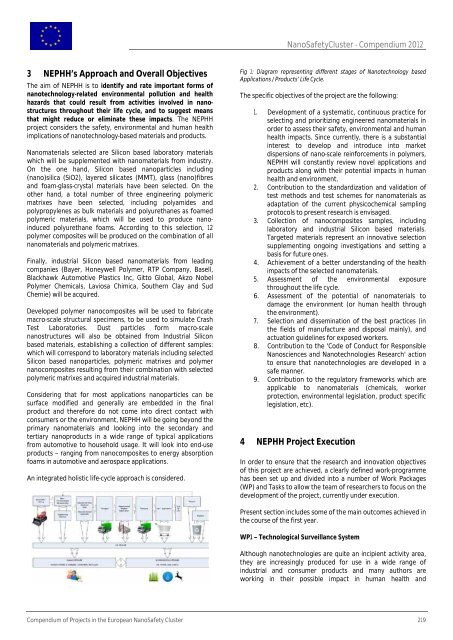Timing, hosts and locations of (grouped) events of NanoImpactNet
Timing, hosts and locations of (grouped) events of NanoImpactNet
Timing, hosts and locations of (grouped) events of NanoImpactNet
You also want an ePaper? Increase the reach of your titles
YUMPU automatically turns print PDFs into web optimized ePapers that Google loves.
3 NEPHH’s Approach <strong>and</strong> Overall Objectives<br />
The aim <strong>of</strong> NEPHH is to identify <strong>and</strong> rate important forms <strong>of</strong><br />
nanotechnology-related environmental pollution <strong>and</strong> health<br />
hazards that could result from activities involved in nanostructures<br />
throughout their life cycle, <strong>and</strong> to suggest means<br />
that might reduce or eliminate these impacts. The NEPHH<br />
project considers the safety, environmental <strong>and</strong> human health<br />
implications <strong>of</strong> nanotechnology-based materials <strong>and</strong> products.<br />
Nanomaterials selected are Silicon based laboratory materials<br />
which will be supplemented with nanomaterials from industry.<br />
On the one h<strong>and</strong>, Silicon based nanoparticles including<br />
(nano)silica (SiO2), layered silicates (MMT), glass (nano)fibres<br />
<strong>and</strong> foam-glass-crystal materials have been selected. On the<br />
other h<strong>and</strong>, a total number <strong>of</strong> three engineering polymeric<br />
matrixes have been selected, including polyamides <strong>and</strong><br />
polypropylenes as bulk materials <strong>and</strong> polyurethanes as foamed<br />
polymeric materials, which will be used to produce nanoinduced<br />
polyurethane foams. According to this selection, 12<br />
polymer composites will be produced on the combination <strong>of</strong> all<br />
nanomaterials <strong>and</strong> polymeric matrixes.<br />
Finally, industrial Silicon based nanomaterials from leading<br />
companies (Bayer, Honeywell Polymer, RTP Company, Basell,<br />
Blackhawk Automotive Plastics Inc, Gitto Global, Akzo Nobel<br />
Polymer Chemicals, Laviosa Chimica, Southern Clay <strong>and</strong> Sud<br />
Chemie) will be acquired.<br />
Developed polymer nanocomposites will be used to fabricate<br />
macro-scale structural specimens, to be used to simulate Crash<br />
Test Laboratories. Dust particles form macro-scale<br />
nanostructures will also be obtained from Industrial Silicon<br />
based materials, establishing a collection <strong>of</strong> different samples:<br />
which will correspond to laboratory materials including selected<br />
Silicon based nanoparticles, polymeric matrixes <strong>and</strong> polymer<br />
nanocomposites resulting from their combination with selected<br />
polymeric matrixes <strong>and</strong> acquired industrial materials.<br />
Considering that for most applications nanoparticles can be<br />
surface modified <strong>and</strong> generally are embedded in the final<br />
product <strong>and</strong> therefore do not come into direct contact with<br />
consumers or the environment, NEPHH will be going beyond the<br />
primary nanomaterials <strong>and</strong> looking into the secondary <strong>and</strong><br />
tertiary nanoproducts in a wide range <strong>of</strong> typical applications<br />
from automotive to household usage. It will look into end-use<br />
products – ranging from nanocomposites to energy absorption<br />
foams in automotive <strong>and</strong> aerospace applications.<br />
An integrated holistic life-cycle approach is considered.<br />
NanoSafetyCluster - Compendium 2012<br />
Fig 1: Diagram representing different stages <strong>of</strong> Nanotechnology based<br />
Applications / Products’ Life Cycle.<br />
The specific objectives <strong>of</strong> the project are the following:<br />
1. Development <strong>of</strong> a systematic, continuous practice for<br />
selecting <strong>and</strong> prioritizing engineered nanomaterials in<br />
order to assess their safety, environmental <strong>and</strong> human<br />
health impacts. Since currently, there is a substantial<br />
interest to develop <strong>and</strong> introduce into market<br />
dispersions <strong>of</strong> nano-scale reinforcements in polymers,<br />
NEPHH will constantly review novel applications <strong>and</strong><br />
products along with their potential impacts in human<br />
health <strong>and</strong> environment.<br />
2. Contribution to the st<strong>and</strong>ardization <strong>and</strong> validation <strong>of</strong><br />
test methods <strong>and</strong> test schemes for nanomaterials as<br />
adaptation <strong>of</strong> the current physicochemical sampling<br />
protocols to present research is envisaged.<br />
3. Collection <strong>of</strong> nanocomposites samples, including<br />
laboratory <strong>and</strong> industrial Silicon based materials.<br />
Targeted materials represent an innovative selection<br />
supplementing ongoing investigations <strong>and</strong> setting a<br />
basis for future ones.<br />
4. Achievement <strong>of</strong> a better underst<strong>and</strong>ing <strong>of</strong> the health<br />
impacts <strong>of</strong> the selected nanomaterials.<br />
5. Assessment <strong>of</strong> the environmental exposure<br />
throughout the life cycle.<br />
6. Assessment <strong>of</strong> the potential <strong>of</strong> nanomaterials to<br />
damage the environment (or human health through<br />
the environment).<br />
7. Selection <strong>and</strong> dissemination <strong>of</strong> the best practices (in<br />
the fields <strong>of</strong> manufacture <strong>and</strong> disposal mainly), <strong>and</strong><br />
actuation guidelines for exposed workers.<br />
8. Contribution to the 'Code <strong>of</strong> Conduct for Responsible<br />
Nanosciences <strong>and</strong> Nanotechnologies Research' action<br />
to ensure that nanotechnologies are developed in a<br />
safe manner.<br />
9. Contribution to the regulatory frameworks which are<br />
applicable to nanomaterials (chemicals, worker<br />
protection, environmental legislation, product specific<br />
legislation, etc).<br />
4 NEPHH Project Execution<br />
In order to ensure that the research <strong>and</strong> innovation objectives<br />
<strong>of</strong> this project are achieved, a clearly defined work-programme<br />
has been set up <strong>and</strong> divided into a number <strong>of</strong> Work Packages<br />
(WP) <strong>and</strong> Tasks to allow the team <strong>of</strong> researchers to focus on the<br />
development <strong>of</strong> the project, currently under execution.<br />
Present section includes some <strong>of</strong> the main outcomes achieved in<br />
the course <strong>of</strong> the first year.<br />
WP1 – Technological Surveillance System<br />
Although nanotechnologies are quite an incipient activity area,<br />
they are increasingly produced for use in a wide range <strong>of</strong><br />
industrial <strong>and</strong> consumer products <strong>and</strong> many authors are<br />
working in their possible impact in human health <strong>and</strong><br />
Compendium <strong>of</strong> Projects in the European NanoSafety Cluster 219






